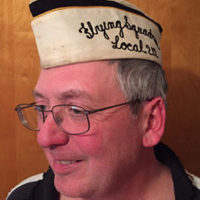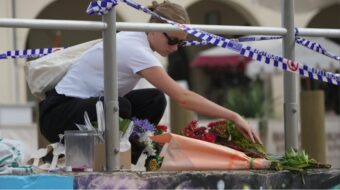
This article won Honorable Mention in the Best Feature Story category at the 2020 Labor Media Awards, presented by the International Labor Communications Association.
“Hello, everyone, are you excited to be here today?”
Forty pairs of animated eyeballs stare back at me while I introduce myself.
“My name is Mailman John and today I am going to show you how a Post Office works.”
The energy of two dozen eight-year-olds envelops the lobby where we stand. Before I can even begin my next sentence their hands begin to rise with queried excitement. These kids are bonkers about being at the Royal Oak Post Office, and so are their teachers. And like a sponge, I absorb this spontaneous combustion of childhood fossil fuel. It makes me happy. This is our annual “School Trip to the Post Office,” and I am lucky enough to be the tour guide again this year.
This local elementary school calls every year looking for a Post Office tour for their third-grade class. This year makes the tenth year or so that I have been involved. I look forward to it with a mixture of nervous anticipation and a slight bit of trepidation. As I look out the window of the lobby waiting for the bus to pull up there are always butterflies in my stomach. “Come on, Big Guy,” I tell myself, “these are just kids. Put on your big boy pants!” They are just kids, right? “Toughest audience in the world bar none,” says the voice in my head. They want answers and they want them now!
We start in the P.O. Box section. For adults, this is quite an innocuous subject, but every year I am amazed by how fascinated these kids are with the concept of a P.O. Box! Then they see a customer use the parcel drop bin or the outgoing letter drop slot — they fight to gaze into the dispensaries, curious as to what happens to that mail piece when it enters the postal void. Each child brings a handwritten letter and drops it into the drop slot, again peering into the slot hoping for a glimpse of its destination.
After we tour the retail store and watch the customers interact with the counter clerks, I unveil the big surprise. I tell them we are going where none of their friends or parents gets to go, through the Blue Door. There I will show them the Big Secret of what happens to the mail after it is dropped through the slots. But there are rules. We all stay together, no running. And nobody touches anything, not even a letter. The Post Office is the guardian of other people’s property, and that trust is sacred. Their eyes bulging, bodies twitching with anticipation, I open the Blue Door. They all want to be the first one in.
They see the backside of the P.O. boxes stuffed with mail and every hand goes up. I am fielding a multitude of questions. I can hardly keep up and my head is swimming. As we move down the row of P.O. boxes we hear a clank and a package comes bouncing into a hamper after being dropped from the lobby. The kids clamor around the hamper hoping for another package drop and they are rewarded. The wails of excitement are astonishing. Then a glorious letter comes through the slot from the other side and more squeals. They look into the letter hamper. “I see my letter, the one I just dropped from the other side!” one exclaims. Mail is exciting!
We go through the carrier casing area, the loading dock, the registry cage (one of the young’uns always claims he could break into it) and take a view of our new postal vehicle, the Promaster, in the parking lot. We end up in the conference room where we watch a short video, “The Adventure of a Letter,” showing the machinery in a mail processing plant, and then the pièce de résistance: I pick someone from the class to wear a letter carrier hat, jacket, and satchel. They all want to wear the “uniform” so this kid I pick is a “Star.” I then put a bundle of “flats” on their arm and a bundle of “letters” in their hand. I give “instructions” to walk and look at the mail at the same time, both bundles. And no “horseplay,” kid — it’s against company rules. With cameras from the teachers clicking, we watch and giggle as the “Star” stumbles and fumbles with the mail. “That was hard” — the usual reply as they happily take off the uniform.
These teachers bring their young students every year for this tour because they want these young minds to have a deeper appreciation of the role of the Post Office in the local community. They go back to their elementary school after the tour and recreate a post office in the school. This is one of the school’s annual traditions and I wish more schools would have this as part of their curriculum.
Before I end the tour I ask the students what else their letter carrier does besides delivering the mail. We discuss how letter carriers make friends with their customers, look out for seniors who live alone, and sometimes help to save people’s lives. I tell them the story about how I helped ninety-year-old Mrs. Lillie, who had broken her hip and lay on the floor for hours until I delivered her mail and heard her screams for help. I let them know that every Letter Carrier I know has a story like that. We also talk about how Letter Carriers raise money for charities like the Muscular Dystrophy Association and how we help to feed hungry families with the Stamp Out Hunger Food Drive, our nation’s largest one-day food drive. This is the one time that the room gets quiet.
It is my fervent hope that every one of these kids, somewhere in the deep recesses of their memories, remembers at least a part of this experience as they get older. We will need their support in the coming years, as they become adults, to keep our Postal Service as vitally important tomorrow as it is today.
There are many in positions of power, unfortunately even some in upper USPS management, who want to distance the Letter Carrier from the very patrons that we strive to serve. From the imposition of neighborhood “cluster boxes” to this new idea of “Consolidated Casing,” the result would be less interaction with our neighborhood communities and less personal service to our patrons. These tours help to remind me why I am a Letter Carrier and the unmistaken magic in a piece of mail, especially a handwritten letter. They don’t know it, and I’ll never tell them, but these kids every year teach me more about the mail than I’ll ever teach them.










